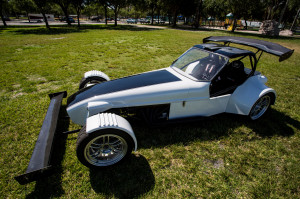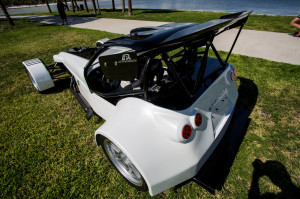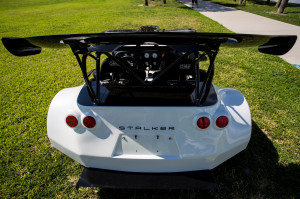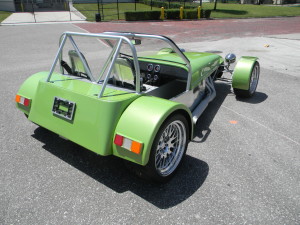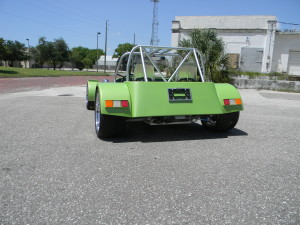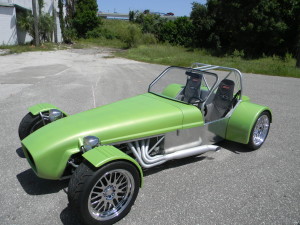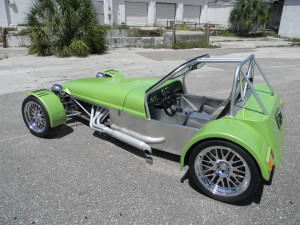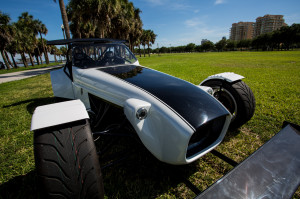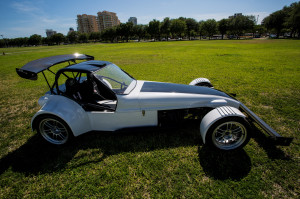Stalker XL
Meet Big Brother
The Stalker XL is the big brother of the Stalker Family. The XL shares the same suspension design as its siblings but in a larger proportion. The passenger compartment is 4″ wider to accommodate larger or more up upholstered seats and more space around the pedals. It also holds large 315/30/18 tires in the rear bringing the overall width out to 76″, 10″ wider than the M-spec or Classic R. To keep things in proportion, the frame was lengthened in the front extending the wheel base 10″ forward bringing it to 105″ wheelbase. The larger engine compartment now has room for forward facing intakes on the LS V8 and even an A/C compressor. The XL is bigger, more comfortable, and increased stability at high speeds.
The suspension is one of the biggest highlights of a Stalker. A good suspension design delivers excellent ride quality and superb handling, the new generation of Stalkers have surpassed expectation. Now made with custom billet spindles, a 5″ x 4.5″ (114.3) wheel pattern, the most desirable of wheel styles are available. The XL uses 17″x9″ wheels and 255/40/17 tires in front and 17″x10″ wheels and 315/30/17 tires in the rear. All wheel hubs feature internal speed sensors for the added use of traction control. The braking system features 4 piston Wilwood calipers front and rear with your choice of 10″ or 12.75″ rotors, hydraulic proportioning valve, and power brake booster.
Front Suspension
The front end features double wishbone setup with inboard shocks via push rods and rockers. The inboard shocks allow for big increases in motion ratio, using more shock and providing better damping and wheel movement control. The Coleman steering rack has precise control of the billet aluminum spindles. The front A arms are 4″ longer than the standard car to make the front width match the big tires in the rear. For the race engineer, nearly every facet of suspension geometry is adjustable. In addition to castor, camber, and toe, there are multiple mount locations for the push rods and shocks to adjust the motion ratio on the fly, thus changing the effective spring rate. The control arms’ mounting locations can be moved to change roll center vs ride height dynamics. The heims can be threaded in or out to change control arm length. Even kingpin inclination can be adjusted.
Rear Suspension
The rear end features double wishbone setup with inboard shocks via push rods and rockers. The inboard shocks allow for flexibility in motion ratio, using more shocks and providing better damping and wheel movement control. The billet aluminum spindles are controlled by a simple toe link. For the race engineer, nearly every facet of suspension geometry is adjustable. In addition to castor, camber, and toe, there are multiple mount locations for the push rods and shocks to adjust the motion ratio on fly thus changing the effective spring rate. The control arms mounting locations can be moved to change roll center vs ride height dynamics. The heims can be threaded in our out to change control arm length. A arms can be mounted at different angles to adjust squat dynamics. The toe link car attachment is adjustable up and down to apply dynamic toe in. Dynamic toe in can be very effective for rear traction on corner exit.
Bodywork
The XL can be equipped with either the Classic or M-spec style body work. The hood is smooth with no scoop. The M-spec style lights can be added to the hood that house a HID projector light with hi/low beams. The front fenders have been louvered to prevent lift at high speed, and house a unique strip of Amber LED turn signals. Either the classic frame less windshield can be used or the M-spec style that is integrated into the roll cage. This style improves aerodynamics and dramatically increases ride quality for highway winds. The rear end, either style, sports widened rear fenders that take on an aggressive look.
Performance
You can not match the performance of a Stalker for the money, or hardly at all for that matter. 0-60mph times range from 2.4 to 4 seconds and 0-100mph times are being clocked in under 5 seconds. The Stalker will leave you breathless almost every time you ride. Speed is only part of the equation. The turning capabilities are unsurpassed. The steering is quick and precise allowing you to pick, choose, and fine tune the perfect apex. The rear end is stable and tamed on and off the throttle. This combination gives you a car that not only pulls high G forces, but is controllable and forgiving on the edge of traction. When not cruising around the streets of your home town, you will see Stalkers on the podium in Autocross, Time Trial events, and passing race prepped exotics at weekend track days.
The Stalker XL is designed to accommodate 2 different engine series. The first being the GM 3.8 V6. This engine is readily available used and very affordable throughout North America in either Naturally Aspirated (200hp,200ftlb) or Supercharged (240-260hp/300ftlb). The second series is the all aluminum LS V8 from GM. This light(350 pounds) and compact V8 is widely available throughout North America in used and new crate form. The LS generation engines range from 5.3 to 7 liter and 330-525 stock hp.
The Stalker XL is designed to accommodate 2 different engine series. The first being the GM 3.8 V6. This engine is readily available used and very affordable throughout North America in either Naturally Aspirated (200hp,200ftlb) or Supercharged (240-260hp/300ftlb). The second series is the all aluminum LS V8 from GM. This light(350 pounds) and compact V8 is widely available throughout North America in used and new crate form. The LS generation engines range from 5.3 to 7 liter and 330-525 stock hp.

